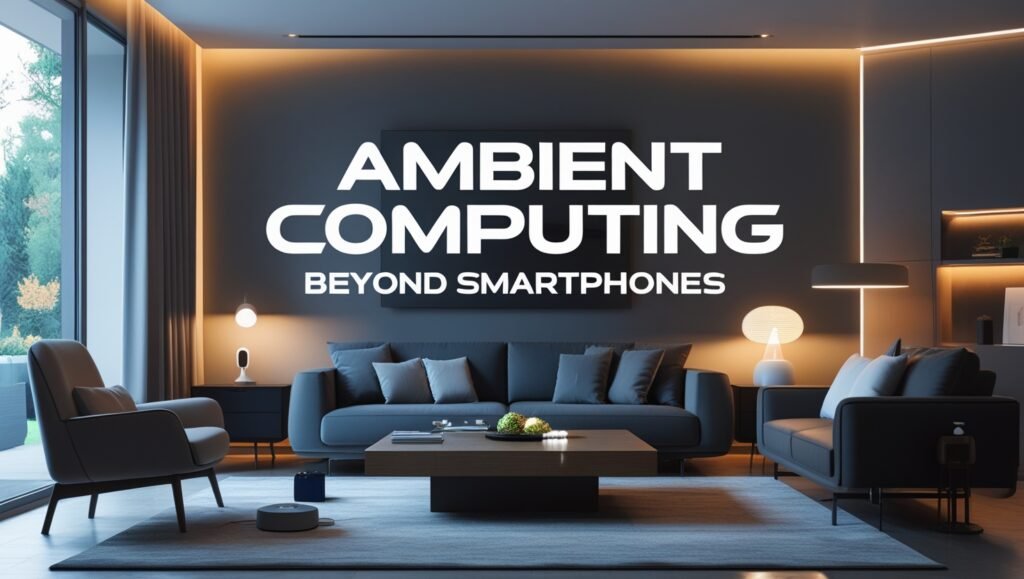
Imagine a world where technology fades into the background, anticipating your needs and responding seamlessly without the constant need to tap, swipe, or click on a handheld device. This isn’t a futuristic fantasy; it’s the burgeoning reality of ambient computing, a paradigm shift that’s moving us beyond our reliance on smartphones.
What Exactly is Ambient Computing?
Ambient computing, at its core, envisions a network of interconnected devices and sensors woven into the fabric of our everyday environments. These intelligent systems work collaboratively to provide information, automate tasks, and enhance our experiences naturally and intuitively. Think of it as technology that’s present but not obtrusive, always ready to assist but never demanding your undivided attention.
- Ubiquitous Presence: Ambient computing isn’t confined to a single device; it’s distributed across various objects and spaces.
- Contextual Awareness: These systems understand your situation, location, and even your intentions to provide relevant and timely assistance.
- Seamless Interaction: Interaction happens naturally, often through voice, gestures, or even simply by your presence.
This shift marks a significant departure from the smartphone era, where we are constantly tethered to a single, central device. Ambient computing promises a more fluid and human-centered technological experience.
Diverse Forms of Ambient Computing in Action:
The beauty of ambient computing lies in its versatility. It’s not just one thing; it’s a collection of technologies working in concert. Here are some key manifestations of this evolving landscape:
- Smart Homes Evolving into Intelligent Habitats: From lights that adjust automatically to thermostats that learn your preferences, our homes are becoming increasingly intelligent environments. Voice assistants, such as Amazon Alexa and Google Assistant, are central to this, enabling hands-free control and access to information.
- Wearables: The Extension of Our Digital Self: Smartwatches and fitness trackers are just the beginning. Future wearables could seamlessly integrate health monitoring, communication, and even augmented reality experiences directly into our clothing or accessories.
- The Rise of the Smart Car and Connected Mobility: Modern vehicles are becoming sophisticated computing platforms on wheels, offering advanced navigation, entertainment, and safety features. The future promises even greater autonomy and seamless integration with our digital lives.
- Smart Cities: An Interconnected Urban Ecosystem: Imagine traffic lights that optimize flow based on real-time data, public transportation that adapts to passenger demand, and energy grids that operate with unprecedented efficiency. Ambient computing is the backbone of the smart city vision.
- Ambient Intelligence in the Workplace: From automated meeting scheduling to personalized workspace adjustments, ambient computing can streamline workflows and enhance productivity in professional environments.
The Technologies Powering Ambient Computing:
The seamless experiences offered by ambient computing are built upon a foundation of several key technological advancements:
- The Internet of Things (IoT): A vast network of physical devices embedded with sensors, software, and connectivity, enabling them to collect and exchange data. IoT devices are the building blocks of ambient computing environments.
- Artificial Intelligence (AI) and Machine Learning (ML): These technologies enable systems to learn from data, understand context, and make intelligent decisions without explicit programming. AI algorithms are crucial for personalization and proactive assistance.
- Cloud Computing: Provides the scalable infrastructure and processing power needed to manage the vast amounts of data generated by ambient computing systems.
- 5G and Advanced Connectivity: High-speed, low-latency wireless networks are essential for ensuring seamless communication and real-time responsiveness across interconnected devices.
- Natural Language Processing (NLP): Allows humans to interact with ambient systems using voice commands and natural language, making technology more accessible and intuitive.
Challenges and Considerations:
While the potential of ambient computing is immense, its widespread adoption also presents several challenges that need careful consideration:
- Privacy Concerns in a Hyper-Connected World: The constant collection of data raises significant questions about individual privacy and security. Robust safeguards and transparent data handling practices are crucial.
- Security Vulnerabilities Across a Distributed Network: With more devices connected to the internet, the attack surface for cyber threats expands. Ensuring the security of all components within an ambient computing ecosystem is paramount.
- Ethical Implications of Proactive and Autonomous Systems: As ambient systems become more intelligent and autonomous, we need to grapple with the ethical implications of their decisions and actions.
- The Digital Divide and Equitable Access: Ensuring that the benefits of ambient computing are accessible to everyone, regardless of their socioeconomic status or geographic location, is essential to avoid exacerbating existing inequalities.
- User Interface and Experience Design in Invisible Interfaces: Designing intuitive and user-friendly interfaces for systems that are meant to be invisible presents unique challenges for designers.
The Future Trajectory of Ambient Computing:
Ambient computing is not just a fleeting trend; it represents a fundamental shift in how we interact with technology. As the enabling technologies continue to mature and become more affordable, we can expect to see ambient computing permeate more and more aspects of our lives. The focus will likely shift towards creating truly seamless and personalized experiences, where technology anticipates our needs and enhances our capabilities without demanding our constant attention. The future envisions a world where technology fades into the background, empowering us to focus on what truly matters.
Conclusion:
Ambient computing promises a future where technology is more intuitive, integrated, and human-centered than ever before. By moving beyond the limitations of the smartphone, we are entering an era of seamless digital experiences that have the potential to transform our homes, workplaces, cities, and ultimately, our lives.
FAQs:
1. What is ambient computing?
A network of interconnected devices enhances experiences seamlessly.
2. How is it different from smartphones?
It distributes computing across environments, not one device.
3. What are some examples?
Smart homes, wearables, smart cars, smart cities.
4. What technologies enable it?
IoT, AI, cloud, 5G, NLP.
5. What are the main challenges?
Privacy, security, ethics, access, interface design.
6. What is the future outlook?
More seamless and personalized technological integration.
